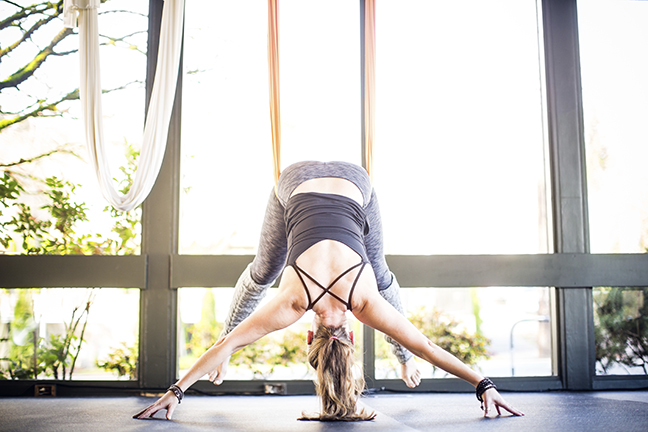For yoga and fitness studio owners, you have a lot to consider: trends, profitability, and sustainability. Here we lay out what you need to consider in order to determine if you have promising opportunity offering anti-gravity yoga classes.
What is Aerial Yoga?
Aerial yoga is practiced with the support of a soft fabric hammock. The purpose is to enhance the experience and skill of traditional asana by using the hammock to support the hips. It was created by aerial performer Christopher Harrison in 2007. His background is as a gymnast and Broadway choreographer. In addition to the support hammock, the equipment rigs include support chains, webbing strap, and carabiners. The hammock is hung from the ceiling, to rest at a height typically between waist and shoulder. The rigs are safe, as they held to the same standards as mountain-climbing gear.
Benefits of Aerial Yoga
Support and Applicability
No yoga experience is required for aerial yoga, and it is for all fitness levels and body types. The hammock can hold up to 2,000 lbs. Some postures an individual may not be able to perform on the ground, can be more accessible mid-air. The elevation also removes any pressure on the head and shoulders.
Physical Health
No clinical trials on the health benefits of aerial yoga have been conducted, however anecdotal evidence demonstrates that, as the body hangs freely, muscles and joints are strengthened and the spine is decompressed. The inversion postures are beneficial for back and sciatic issues. Further, while aerial yoga is accessible to all fitness levels, offering anti-gravity classes can attract more of a hard-core fitness crowd then regular yoga might. This video demonstrates this.
Combats Workout Boredom
The intrigue and freshness of using a hammock in one’s fitness routine alone will combat workout boredom and disinterest. But also, the participant experiences an elating sense of flying, which makes an aerial workout super fun.
Psychological Health
Aerial yoga, and even other aerial workouts, can be quite meditative. It requires focus, and the hammock offers a sense of safety and security in a normally potentially scary situation. The practice fosters a relaxed and peaceful state of mind.
Convenience
Aerial workout classes offer a total body workout without the participant having to do anything other than show up.
Should I Offer Aerial Workout Classes at My Studio?
Here is a great article from a first-time aerial student. It may help with some perspective. In terms of profitability, consider the impact on attendance to your existing classes. You will get some students trying aerial instead, while waning clients may have their love of yoga re-ignited. Also, you demonstrate your studio’s ability to stay on the cutting edge of yoga, while also attracting new clients. You can charge a bit more for aerial classes, depending on what you charge for regular classes. We’ve seen classes ranging from $19 to $25. If your studio offers memberships, adding a variety of classes for a variety of workouts and schedules is incentive to join. You will also distinguish your studio from others nearby. Our recommendation is to poll students, and possibly even other local fitness buffs (consider partnering with a Crossfit gym, e.g.) to gauge interest. With an interested market and good teachers, aerial yoga classes can be very profitable.
You will need an insurance policy specific to aerial arts, as a regular fitness, dance and yoga insurance policies do not cover aerial activities.

